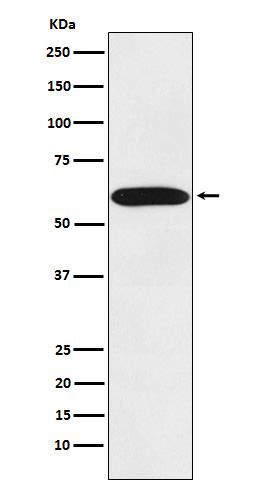
| WB | 1/500-1/1000 | Human,Mouse,Rat |
| IF | 1/20 | Human,Mouse,Rat |
| IHC | 1/50-1/100 | Human,Mouse,Rat |
| ICC | 1/50-1/200 | Human,Mouse,Rat |
| FCM | 1/50-1/100 | Human,Mouse,Rat |
| Elisa | 咨询技术 | Human,Mouse,Rat |
| Aliases | Hop; P60; STI1; STI1L; STIP1; Stress induced phosphoprotein 1 |
| Entrez GeneID | 10963 |
| WB Predicted band size | Calculated MW: 63 kDa; Observed MW: 63 kDa |
| Host/Isotype | Rabbit IgG |
| Antibody Type | Primary antibody |
| Storage | Store at 4°C short term. Aliquot and store at -20°C long term. Avoid freeze/thaw cycles. |
| Species Reactivity | Human,Mouse,Rat |
| Immunogen | A synthesized peptide derived from human STIP1 |
| Formulation | Purified antibody in PBS with 0.05% sodium azide. |
+ +
以下是关于STIP1抗体的3篇参考文献及其摘要内容:
1. **文献名称**: "STIP1 overexpression as a prognostic biomarker in hepatocellular carcinoma"
**作者**: Wang et al., 2018
**摘要**: 该研究通过免疫组化(IHC)和Western blot分析,发现STIP1在肝癌组织中显著高表达,且与肿瘤分期和患者生存率负相关。研究利用STIP1抗体证实其可作为肝癌预后标志物。
2. **文献名称**: "STIP1 promotes breast cancer progression by regulating ERK signaling"
**作者**: Chen et al., 2020
**摘要**: 该研究通过ELISA和免疫荧光技术(使用STIP1抗体)检测乳腺癌细胞系及临床样本,发现STIP1通过激活ERK通路促进肿瘤细胞增殖和转移,提示其作为治疗靶点的潜力。
3. **文献名称**: "STIP1 as a novel diagnostic marker for gastric cancer"
**作者**: Zhang et al., 2021
**摘要**: 研究采用STIP1抗体检测胃癌患者血清和组织中的蛋白水平,发现STIP1表达与肿瘤侵袭深度和淋巴结转移密切相关,提出其可作为胃癌早期诊断的血清标志物。
4. **文献名称**: "STIP1 interacts with HSP90 to enhance colorectal cancer cell survival"
**作者**: Liu et al., 2019
**摘要**: 通过共免疫沉淀(Co-IP)和IHC实验(使用STIP1抗体),研究发现STIP1与HSP90形成复合物,抑制结直肠癌细胞凋亡,提示其通过分子伴侣功能促进肿瘤耐药性。
这些研究均使用STIP1抗体探索其在肿瘤中的生物学功能及临床意义,涵盖肝癌、乳腺癌、胃癌和结直肠癌等类型。
STIP1 (Stress-Induced Phosphoprotein 1), also known as HOP or STI1. is a co-chaperone protein that facilitates interactions between heat shock proteins HSP70 and HSP90. playing a critical role in cellular stress response and protein quality control. Structurally, it contains three tetratricopeptide repeat (TPR) domains that mediate binding to HSP70 and HSP90. and a STI1-like domain involved in client protein interactions. STIP1 assists in the transfer of client proteins between HSP70 and HSP90 during chaperone-mediated folding, ensuring proper conformational maturation and preventing aggregation of misfolded proteins.
Antibodies targeting STIP1 are widely used in research to study its expression, localization, and interactions in physiological and pathological contexts. Elevated STIP1 levels have been linked to cancer progression, where it promotes cell proliferation, metastasis, and therapy resistance. It is also implicated in neurodegenerative diseases, such as Alzheimer’s and Parkinson’s, due to its role in managing misfolded protein aggregates. In diagnostics, STIP1 antibodies are employed in techniques like Western blot, immunohistochemistry, and ELISA to assess its expression in tissues or biofluids as a potential biomarker. Therapeutic applications are under exploration, with studies investigating STIP1-blocking antibodies to disrupt oncogenic chaperone networks or pathological protein interactions. Its dual role in stress adaptation and disease makes STIP1 a compelling target for both mechanistic studies and clinical translation.
×